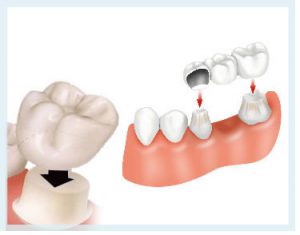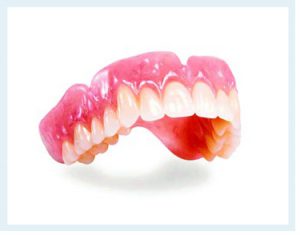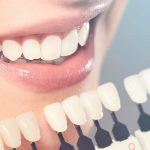Prosthetics
Prosthetics refer to the prepared materials used to repair or replace teeth and surrounding tissues that have been damaged or completely lost due to various reasons.
What Is the Purpose of Prosthetics?
The purpose of prosthetic treatment is to restore the lost functions of the patient, correct impaired speech, and improve aesthetic appearance. In this way, not only is oral health largely restored, but individuals who have to live with missing or damaged teeth are also supported psychologically.
People who must continue their lives this way often forget how to smile. In addition to functional problems, this leads to a loss of self-confidence.
Various types of prostheses aim to improve the quality of life for such patients.
Types of Prosthetics
In general, prosthetics used to replace missing teeth fall into two main categories:
-
Fixed Prosthetics
-
Removable Prosthetics
Fixed Prosthetics

These are prosthetics made to replace the visible parts of the teeth and cannot be removed by the patient. They are also known as crowns or porcelain teeth.
Fixed prosthetics are used in the restoration of teeth with significant material loss due to decay or other reasons, in discolored teeth that cannot be whitened, or in teeth with shape deformities. The teeth are shaped to receive crowns. Then, impressions are taken, and the prosthetics are prepared in laboratories according to your dentist’s instructions. After trial fittings, the crown is cemented, and the procedure is completed.
The maintenance of crowns should be the same as that of natural teeth. A well-made crown should be indistinguishable from a healthy tooth in terms of function and hygiene. These crowns are made using porcelain, precious metal combinations, special glass materials, or special plastics, depending on your dentist’s selection.
Bridges are prosthetics made to replace missing teeth by taking support from adjacent teeth. In this type of restoration, both neighboring teeth are prepared, and the bridge connects all teeth involved. If a bridge is not made to replace the missing tooth, the adjacent teeth and the opposing tooth from the other jaw will move toward the extraction space. This causes misalignment of the bite, which can lead to cavities and tooth loss. As with crowns, the supporting teeth are shaped, and the same procedures are followed. In addition to routine care, the area under the pontic (the artificial tooth) should be cleaned with special dental floss, as shown by your dentist.
Removable Prosthetics

Removable prosthetics are used to compensate for tooth loss in cases where fixed prosthetics cannot be applied. Unlike fixed prosthetics, they can be inserted and removed by the patient. They are made of special plastic or a combination of metal and plastic. They are designed to restore aesthetics and function. In cases that require removable prosthetics, there is usually extensive tooth loss, and the prosthesis is necessary to restore chewing function and prevent damage to the remaining teeth. Removable prosthetics are used when all or most teeth are missing.
Removable prosthetics may be made of a combination of special plastics and metals or only special plastics depending on the case. The artificial teeth used in these prosthetics are generally made of plastic. Porcelain teeth are not recommended as they are heavier, transmit forces inappropriately to soft tissues, and do not bond well with plastic.
To maintain removable prosthetics, they should be removed and brushed after every meal. Once a day, they should be cleaned with special cleansing agents. Some substances may damage prostheses that contain metal, so they should not be used without consulting a dentist. When not in use, the prosthesis should be kept in clean water to prevent it from drying out and deforming. You should have your removable prosthetic checked every three years and replace it if necessary. Over time, the prosthesis may wear out, break, or lose its compatibility with the jaw, which can damage the jawbone.
The first month with a removable prosthetic is a period of adjustment in terms of chewing and speaking functions. Any incompatibilities (sore spots) caused by the prosthesis should be resolved through follow-up appointments.
The loss of a tooth can harm your health in many ways. The teeth in front of and behind the missing tooth tend to lean into the gap. The opposing tooth also moves into the extraction space, as teeth tend to seek contact. These shifts and elongations disturb tooth alignment and contact, increasing the accumulation of food debris and bacterial plaque. These areas are difficult to clean, which raises the risk of cavities and gum disease. All these problems can be prevented by replacing the missing tooth. However, replacing the tooth becomes more difficult once the neighboring teeth have leaned and the opposing tooth has over-erupted.
All of these methods have advantages and disadvantages. Your dentist is your best guide in determining which method is most suitable for you.
In removable prosthetics, the metal hooks used to attach the prosthesis to the natural teeth are called clasps. Many people are uncomfortable with the appearance of these metal parts in their mouths. However, advancing dental technology offers a much more aesthetic solution.
By using precision attachments or telescopic crowns, it is possible to retain the prosthesis while avoiding the unesthetic appearance of metal clasps.
Precision Attachments
A precision attachment is a system used instead of the metal parts called clasps that ensure retention in removable prosthetics. The teeth in front of the edentulous area are prepared similarly to crowns, and the fixed part of the precision attachment is cast into the crown on these teeth. The removable part is integrated into the removable prosthetic.
Aside from the absence of clasps, the rest of the removable part is made in the same way as a regular removable prosthesis.
Precision attachments are preferred because they offer better aesthetics and retention and help prevent decay and other problems caused by food buildup around clasps.


